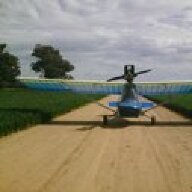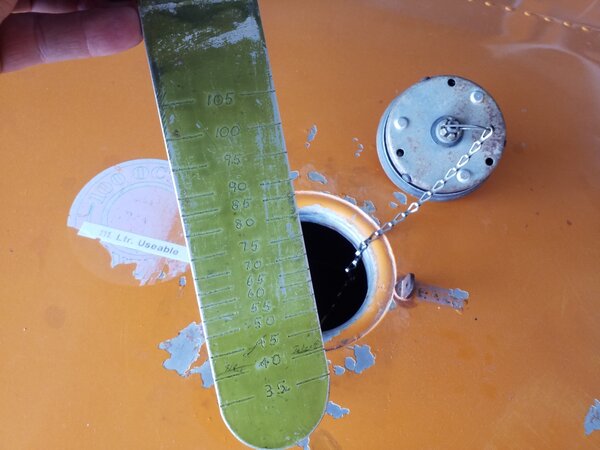-
Posts
3,051 -
Joined
-
Last visited
-
Days Won
64
Content Type
Profiles
Forums
Gallery
Downloads
Blogs
Events
Store
Aircraft
Resources
Tutorials
Articles
Classifieds
Movies
Books
Community Map
Quizzes
Posts posted by Thruster88
-
-
Did not see any faults and have not heard of anything but if it was to crack it would happen inside the stainless brackets and not be visable from the outside. Mine has about 1300tt nearly all by me and no training.Did you find anything? What have you heard? Mine looks sound from the outside. Saw this point fracture on a Gemini at Holbrook 25 yrs ago. Not fatal but still not good. Rgds Don -
-
The Rotax 912 is absolutely a real engine, I would rate it equally for reliability with a lycoming. I think you will find the brake specific fuel consumption is very similar as well, my 160 hp burns 33lph. Props make the noise.Real engine ??? - My Rotax 912 ULS gets me off the ground/grass (slight up hill gradient) with full fuel in sub 100 m - climb out @1500 + ft/min 60-70 knots & I can cruise at 50 - 120 knots on 8 - 18 LPH unleaded. On top of all that its so quiet my neighbours mowers make more noise. You what you can do with Uncle Sams LyCon's ......! -
Stepping up to the lycoming 0-320 should make it all very enjoyable.
-
 1
1
-
-
Hi Kevin, it will be interesting to see if your egt increases when you coursen the prop as per Jabiru SB 18-2.
-
The link from today's e newsletter (board evaluation) isn't working for me. Could someone provide a link, thanks.
-
The how to turn a propeller or fan using a nuclear reactor in a light weight package may not be solved yet.
-
It didn't show in ATSB search for Beverley, ultralight accidents are not often investigated by the atsb but this fuel related one happened at Beverley.I'd be interested to read the accident report on that one. . .https://www.atsb.gov.au/publications/investigation_reports/1984/aair/aair198404508/
-
LH Aviation LH-10 145knots on a 100hp Rotax
-
Crash was caused by pilots failure to maintain airspeed, the engine failure was a casual factor.crash was deemed to be simply the result of failing to ensure a fuel tank tap was turned on. -
Feathering obviously makes a huge difference from drifting down to being able to climb on one. The 2002 pilot did at least manage the drift down rather well although it would have been prudent to land sooner.
-
Junkers ju 287
-
The report (2002) indicates that the right engine "failed" due to no fuel in the right tank, so it's unlikely that it was producing any useful power.
-
 1
1
-
-
This Beech 76 made it back in a similar situation (propeller not feathered) with 3 pax.
https://www.atsb.gov.au/publications/investigation_reports/2002/aair/aair200200047/
-
The reporting goes on, but no details and once again I think they have reported the same incident with 2 different planes.
I really cannot see how we can be having all these incidents, because according to the RAAus site we have flown a total of 2519.1 hours and that is 0.26 hours per pilot in a year. Their numbers, not mine.
As we have 3365 aircraft according to them, that equates to 0.75 hours per plane. We also have 9668 pilots flying those 2519.1 hours, which means 3.83 hours per pilot.
If RAAus cannot put in the correct figures, or even see that they are obviously incorrect, plus they cannot bring the incident reports into any semblance of sense, how can they be contributing to safe flying.
I know I should talk to them about this, but it is a complete waste of time.
2519.1 hours flown for the first 17? Days of 2019 is only going to be 54,086 hours for the full year, so get out and start flying you slackers
-
Did anyone see the total for 2018 ? Last time I checked the RAA site in early December we had flown about 400,000 hours, makes for a good accident rate.
-
The pilots were facing a runaway trim, why it was happening does not matter.They run a "differences" course but don't tell you about the differences. They are now altering the "software". Bit late for 189 people and the Companies reputation. There used to be a saying... "If it's not Boeing I'm not going" All the systems are made by the same manufacturer (Honeywell) but the system LOGIC varied. There was usually less "Mystery" with The LAZY "B". "What's the bloody thing doing now?" stuff. It's a trend to leave the Pilot out of the loop as not being important.. Airbus started the "pilot safe" aeroplane myth. NevAs you would know facthunter all ? 737's have 2 large trim wheels tha rotate whenever trim is happening and 2 switches to stop electric trim, one stops autopilot trim and the other stop ALL electric trim even the MCAS ?.
I am only a PPL and have only looked at a 737 POH for five minutes but i have always been aware of runaway electric trim as any pilot should be. It's a shame the CVR can't be found.
-
I mean the factory setups drawing from the inner guard area compared to the HQ Holden etc sucking out of the engine bay.Thruster - The cold air intake on cars today is more usually an aftermarket addition, as most car manufacturers today have no controls on air intake temperatures. -
The prop will require less power on a hot day for a fixed rpm. This why there is only one static rpm in the POH and no allowance for altitude or density altitude. Orange NSW on a 35 C day, DA 6000' would still give me 2450rpm but the power is way down compared to sea level.To do the test well you need to somehow have the same output power from the engine under the two conditions. The hotter test will need the throttle to be slightly more open to produce the same power.Any efficiency tests would have to be done on a good dyno to measure the power produced.
-
 1
1
-
-
I wonder why none of the car manufacturers are adopting this, they all seem to have cold air intakes on EFI engines. Maybe their engineers are not very smart.Some of the very long distance flight done in the long Eze's were done with a little bit of carb heat applied in the cruise, not to ward of icing but to improve efficiency. -
It's the beech 23, 220 total, a lot for a little plane.One Hundred & five litres.Seems a lot for a 582 Rotax, Or do you do a lot of long distance flying ?. (20 LpH =5 hour)
spacesailor
-
-
Engines lose about 3% power for each 1000' alt increase. From our BAK I we know that 1 degrees C is 120' of density altitude, so your +10-20 C inlet temp would result in a 3-7 HP loss.My main interest however is any real world/significant benefits that I may expect from reducing the engine compartment in flight temperatures or at least delivering cool air to the carbi's - what think you ?? -
Could the muffler be moved to the left a bit (headers rotated anti clockwise viewed from the front ?





The Day the Music Died.
in Aircraft Incidents and Accidents
Posted
Not much has changed 60 years later